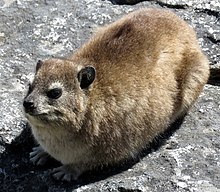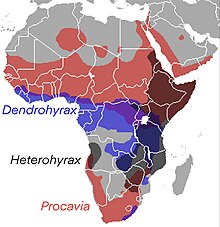| Hyraxes Temporal range: Eocene–recent
| |
|---|---|

| |
| Rock hyrax (Procavia capensis) Erongo, Namibia | |
| Scientific classification | |
| Domain: | Eukaryota |
| Kingdom: | Animalia |
| Phylum: | Chordata |
| Class: | Mammalia |
| Superorder: | Afrotheria |
| Clade: | Paenungulatomorpha |
| Grandorder: | Paenungulata |
| Order: | Hyracoidea Huxley, 1869 |
| Subgroups | |
|
For extinct genera, see text | |

| |
| The range map of Procaviidae, the only living family within Hyracoidea | |
Hyraxes (from Ancient Greek ὕραξ hýrax 'shrew-mouse'), also called dassies,[1][2] are small, stout, herbivorous mammals in the order Hyracoidea. Hyraxes are well-furred, rotund animals with short tails.[3] Modern hyraxes are typically between 30 and 70 cm (12 and 28 in) in length and weigh between 2 and 5 kg (4 and 11 lb). They are superficially similar to marmots, or over-large pikas, but are much more closely related to elephants and sea cows. Hyraxes have a life span from 9 to 14 years. Both types of "rock" hyrax ( P. capensis and H. brucei) live on rock outcrops, including cliffs in Ethiopia[4] and isolated granite outcrops called koppies in southern Africa.[5]
With one exception, all hyraxes are limited to Africa; the exception is the rock hyrax (P. capensis) which is also found in adjacent parts of the Middle East.
Hyraxes were a much more diverse group in the past encompassing species considerably larger than modern hyraxes. The largest known extinct hyrax, Titanohyrax ultimus, has been estimated to weigh 600–1,300 kilograms (1,300–2,900 lb), comparable to a rhinoceros.[6]
- ^ "Hyracoidea". Grzimek's Animal Life Encyclopedia. Vol. 15 Mammals (online ed.). Gale Publishing.
- ^ "Dassie, n.". Dictionary of South African English (web ed.). Dictionary Unit for South African English. 2018. Retrieved 25 February 2019.
- ^ Wilson, Don E.; Mittermeier, Russell A. (eds.). Handbook of the Mammals of the World. Vol. 2. Barcelona, ES: Lynx Edicions. p. 29. ISBN 978-84-96553-77-4.
- ^ Aerts, Raf (2019). "Forest and woodland vegetation in the highlands of Dogu'a Tembien". In Nyssen, J.; Jacob, M.; Frankl, A. (eds.). Geo-trekking in Ethiopia's Tropical Mountains: The Dogu'a Tembien district. Springer Nature. ISBN 978-3-030-04954-6. Retrieved 18 June 2019.
- ^ Mares, Michael A. (2017). Encyclopedia of Deserts. University of Oklahoma Press. p. 288. ISBN 978-0-8061-7229-3 – via Google books.
- ^ Tabuce, Rodolphe (18 April 2016). "A mandible of the hyracoid mammal Titanohyrax andrewsi in the collections of the Muséum National d'Histoire Naturelle, Paris (France) with a reassessment of the species". Palaeovertebrata. 40 (1): e4. doi:10.18563/pv.40.1.e4.